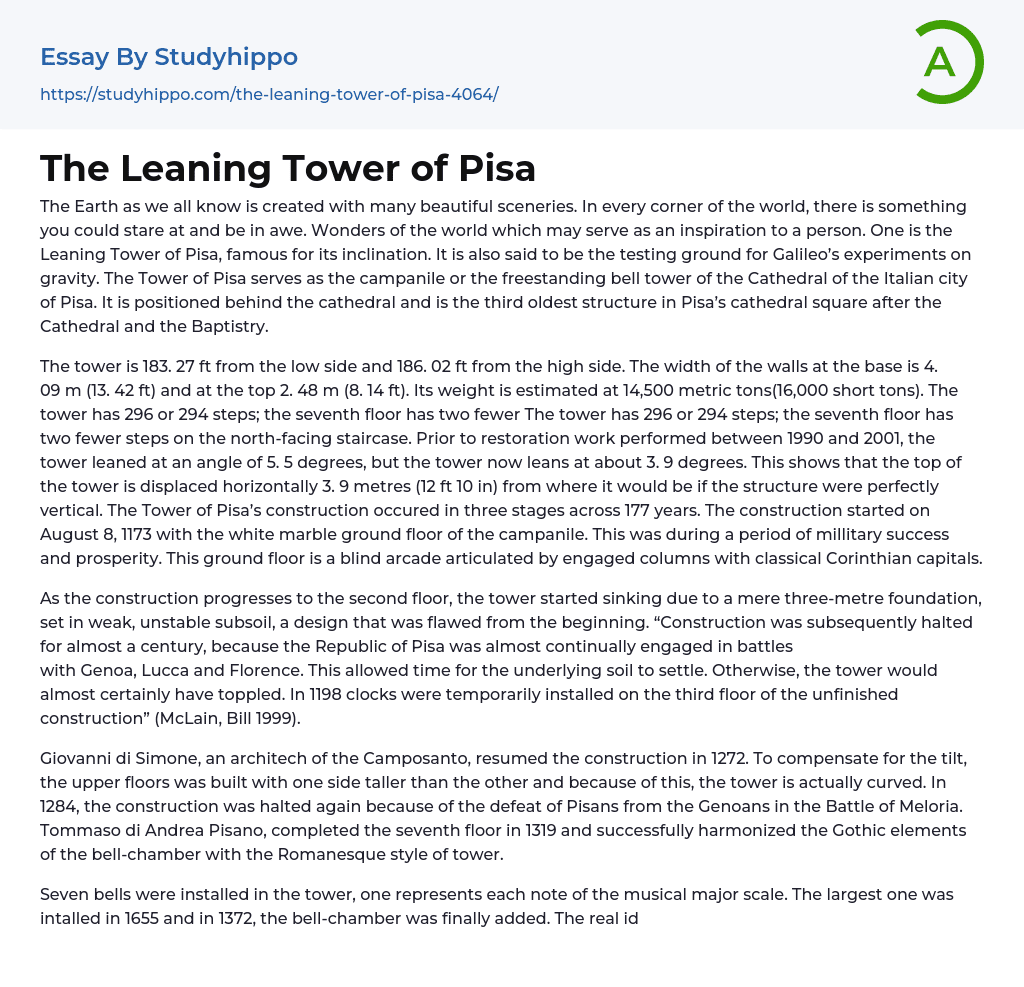The Earth as we all know is created with many beautiful sceneries. In every corner of the world, there is something you could stare at and be in awe. Wonders of the world which may serve as an inspiration to a person. One is the Leaning Tower of Pisa, famous for its inclination. It is also said to be the testing ground for Galileo’s experiments on gravity. The Tower of Pisa serves as the campanile or the freestanding bell tower of the Cathedral of the Italian city of Pisa. It is positioned behind the cathedral and is the third oldest structure in Pisa’s cathedral square after the Cathedral and the Baptistry.
The tower is 183. 27 ft from the low side and 186. 02 ft from the high side. The width of the walls at the base is 4. 09 m (13. 42 ft) and at t
...he top 2. 48 m (8. 14 ft). Its weight is estimated at 14,500 metric tons(16,000 short tons). The tower has 296 or 294 steps; the seventh floor has two fewer The tower has 296 or 294 steps; the seventh floor has two fewer steps on the north-facing staircase. Prior to restoration work performed between 1990 and 2001, the tower leaned at an angle of 5. 5 degrees, but the tower now leans at about 3. 9 degrees. This shows that the top of the tower is displaced horizontally 3. 9 metres (12 ft 10 in) from where it would be if the structure were perfectly vertical. The Tower of Pisa’s construction occured in three stages across 177 years. The construction started on August 8, 1173 with the white marble ground floor of the campanile. This was during a perio
of millitary success and prosperity. This ground floor is a blind arcade articulated by engaged columns with classical Corinthian capitals.
As the construction progresses to the second floor, the tower started sinking due to a mere three-metre foundation, set in weak, unstable subsoil, a design that was flawed from the beginning. “Construction was subsequently halted for almost a century, because the Republic of Pisa was almost continually engaged in battles with Genoa, Lucca and Florence. This allowed time for the underlying soil to settle. Otherwise, the tower would almost certainly have toppled. In 1198 clocks were temporarily installed on the third floor of the unfinished construction” (McLain, Bill 1999).
Giovanni di Simone, an architech of the Camposanto, resumed the construction in 1272. To compensate for the tilt, the upper floors was built with one side taller than the other and because of this, the tower is actually curved. In 1284, the construction was halted again because of the defeat of Pisans from the Genoans in the Battle of Meloria. Tommaso di Andrea Pisano, completed the seventh floor in 1319 and successfully harmonized the Gothic elements of the bell-chamber with the Romanesque style of tower.
Seven bells were installed in the tower, one represents each note of the musical major scale. The largest one was intalled in 1655 and in 1372, the bell-chamber was finally added. The real identity of the architect of the Leaning Tower of Pisa built controversy, but for many years the design was attributed to Guglielmo and Bonanno Pisano. a well-known 12th-century resident artist of Pisa, famous for his bronze casting, particularly in the Pisa Duomo. Bonanno Pisano left Pisa in 1185 for Monreale, Sicily, only to come back and die in his home town.
A piece of
cast with his name was discovered at the foot of the tower in 1820, but this may be related to the bronze door in the facade of the cathedral that was destroyed in 1595. However recent studies seem to indicate Diotisalvi as the original architect due to the time of construction and affinity with other Diotisalvi works, notably the bell tower of San Nicola and the Baptistery, both in Pisa. However, he usually signed his works and there is no signature by him in the bell tower which leads to further speculation (Pierotti, Piero, 2001).
Bibliography
- Webliography "EUROPE | Saving the Leaning Tower".
- BBC News. December 15, 2001. Retrieved May 9, 2009.
- "Tower of Pisa". Archidose. org. June 17, 2001. Retrieved May 9, 2009.
- "Leaning Tower of Pisa (tower, Pisa, Italy) – Britannica Online Encyclopedia". Britannica. com. Retrieved May 9, 2009.
- McLain, Bill (1999). Do Fish Drink Water?. New York: William Morrow and Company, Inc. pp. 291–292. ISBN 0-688-16512-5.
- A profile of an engineer employed to straighten the tower Ingenia, March 2005 http://en. wikipedia. org/wiki/Leaning_Tower_of_Pisa
- Arch essays
- Area essays
- Accounting essays
- Marketing essays
- Automation essays
- Business Cycle essays
- Business Model essays
- Business Operations essays
- Business Software essays
- Corporate Social Responsibility essays
- Infrastructure essays
- Logistics essays
- Manufacturing essays
- Multinational Corporation essays
- Richard Branson essays
- Small Business essays
- Cooperative essays
- Family Business essays
- Human Resource Management essays
- Sales essays
- Market essays
- Online Shopping essays
- Selling essays
- Strategy essays
- Management essays
- Franchising essays
- Quality Assurance essays
- Business Intelligence essays
- Corporation essays
- Stock essays
- Shopping Mall essays
- Harvard Business School essays
- Harvard university essays
- Trade Union essays
- Cooperation essays
- News Media essays
- Waste essays
- Andrew Carnegie essays
- Inventory essays
- Customer Relationship Management essays
- Structure essays
- Starting a Business essays
- Accounts Receivable essays
- Auditor's Report essays
- Balance Sheet essays
- Costs essays
- Financial Audit essays
- International Financial Reporting Standards essays
- Tax essays
- Accountability essays




